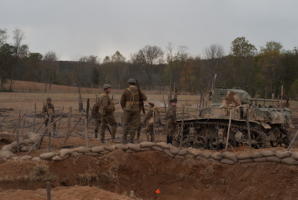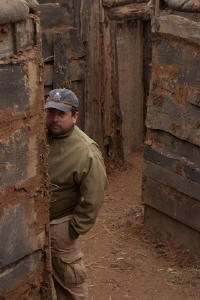|
Get
to know your VMMV staff & vehicles
In this
section we introduce you to the people and armor of the Virginia
Museum of Military Vehicles. We will chat with the VMMV staff,
so that you can get to know the people who "keep 'em running"
and work so hard behind the scenes. And also provide a behind-the-scenes
look into the history of individual vehicles in the VMMV collection.
In this, our 26th newsletter, we discuss VMMV's recent armored
invasion of West Virginia.
What
do VMMV, Gen. George Patton, Gen. BlackJack Pershing, Gen. Bernard
Montgomery, and West Virginia have in common? They all came
together for a TV production in October 2013 about great leaders
in wartime. VMMV supplied the authentic backdrop for the segments
on Gen. Patton by providing an M4A1 and M4A3 Sherman, along
with an M5A1 Stuart. No computer-generated tanks here-nothing
but genuine US-made steel from the 1940s!!!
The process
started back in mid-summer when VMMV was contacted by the production
company about providing authentic armored vehicles for filming
a series about the great leaders of WWII. Since that fits right
in with our motto, VMMV was happy to work with them. The production
company selected an M4A1 Sherman, an M4A3 Sherman, and an M5A1
Stuart since the focus of this particular episode was on the
great US tanker, Gen. George S. Patton.
VMMV
worked with the production company to educate them about the
unique logistics of WWII armored vehicles. After all, you just
can't drive a 35 ton tank down the road like it was an everyday
commuter car. Permits for oversize loads were pulled; routes
and timing were planned by the production company to fit their
shooting schedule.
Meanwhile,
VMMV's skilled group of staff and volunteers pulled the three
vehicles from storage and went over them with a fine tooth comb.
Fluid levels were checked and re-checked; where necessary they
were topped off. Battery connections were tightened down. And
in the case of the M4A3, VMMV repainted the vehicle to suit
the marking scheme desired by the production company. But only
after VMMV verified it would be historically correct….after
all, VMMV always desires to represent the historical truth.
In addition
to preparing the actual tanks, VMMV's workers were busy preparing
a logistics support package. You can't just find an oil filter
for an M4A1 Sherman at your local auto parts store. Tools, large
and small, were placed in the VMMV maintenance truck. A pile
of spare parts were pulled-just in case, and fuel tanks were
filled…..VMMV is a turnkey operation!!!
When
the time came, the big rigs with their lowboy decks pulled in
to VMMV and the two Shermans and the Stuart were loaded. VMMV
technicians drove the vehicles up and on to the decks, always
aided by a ground guide for safety. The tanks were secured with
heavy steel chains by the trucking company to ensure our tanks
remained safe and secure.
The tanks
and maintenance truck arrived in West Virginia in early October.
After unloading, the VMMV crew swarmed over the Shermans and
Stuart to ensure there was no damage during the trip. Checks
were made and everything was perfect. The crew then started
to look around.
They
saw a superb re-creation of a WWI battlefield, complete with
trench line, bunkers, barbed wire and outposts-reflective of
the type of combat and "No Mans Land" seen by Gen.
Patton early in his career. After a bit, other actors representing
great leaders of the time wandered by, such as Winston Churchill.
CLICK
ON PICTURES TO ENLARGE.
Our crew
then ate a big dinner and went to bed early, knowing that long
days were ahead. The alarm clock rang waaaaaaay too early the
next morning, but our drivers and mechanics were already going
about their business-readying the tanks so that they would be
instantly available when needed by the production company.
Multiple
segments centered on the army career of Gen. Patton were filmed.
All of VMMV's vehicles performed flawlessly, a testimony to
the tip-top shape that VMMV's skilled mechanics keep them in.
Shermans rolled over the countryside in a convoy, while the
Stuart scampered about in the mud. The growl of tank engines
filled the air as our drivers maneuvered the vehicles with the
skill of legendary NASCAR driver Dale Earnhardt taking the checkered
flag at Daytona.
After
a week of 12+ hour days, shooting wrapped up. VMMV mechanics
began a reverse movement, loading up the tanks for the return
to Nokesville. Handshakes were exchanged between new friends,
after all, three WWII tanks are a great ice-breaker and conversation
starter!!!
Oh, we
know some of you want to know….the Craft Services during
the shooting got thumbs up from all around!
|


















